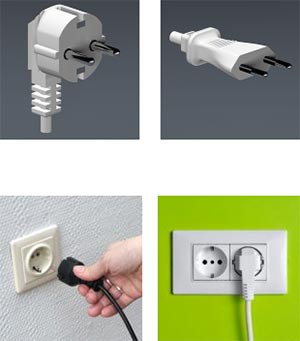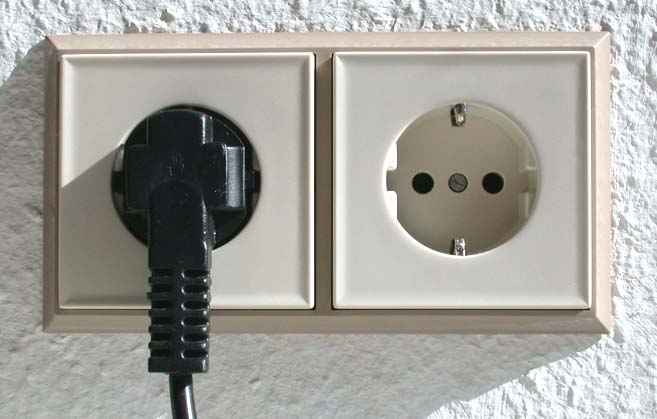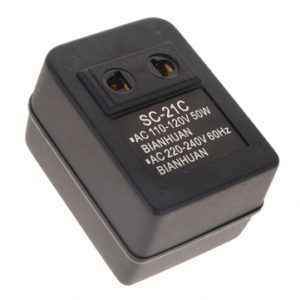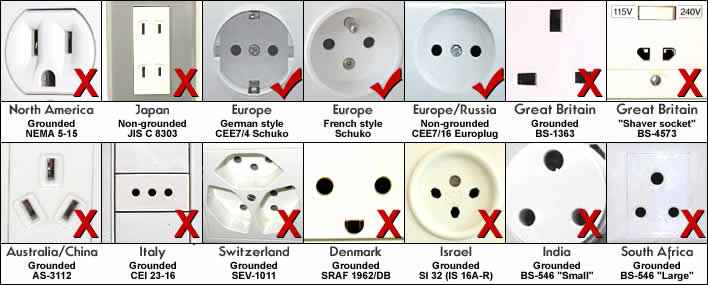All information about electrical plug and voltage in order for you to know what devices work or not, and what do you need to use safely your electronic devices when arriving Alcalá.
Leer en Español: Enchufes y voltaje eléctrico en España
Voltage in Spain is 220 V, same that in almost all European countries. However, in many nations—including most part of American continent, Japan and others—, the voltage is different. Therefore, you should be very careful with any electric device you bring to Spain. Physical difference between plugs is another important detail to take into account, as they are not the same in every either in every place.
Plugs and Electrical sockets (outlets)
In order to know if you will be able to use without problems your electric and electronic devices, the first thing you should pay attention to is the plug. In Spain, there are Schuko (Type F) and Europlug (Type C) plugs. Schuko plugs have two round pins of 4,8 mm diameter and some earthing clips in the upper and lower part acting as a ground wire. In turn, Europlug are flat, also with two round pins, and normally founded in low-power devices. In fact, most common outlets are Type F, Type C electrical sockets could only be found in old houses.
 The only European countries in which plugs and outlets format are different are United Kingdom, Ciprus, Ireland and Malte, using BS 1363 plugs with three flat pins. This is also common among some Asiatic countries such as Hong Kong, Malaysia or Singapore. Most American countries use Type A or B plugs. Type A has two flat pints, while Type B has two flat pins and a round third one.
The only European countries in which plugs and outlets format are different are United Kingdom, Ciprus, Ireland and Malte, using BS 1363 plugs with three flat pins. This is also common among some Asiatic countries such as Hong Kong, Malaysia or Singapore. Most American countries use Type A or B plugs. Type A has two flat pints, while Type B has two flat pins and a round third one.
To use any of these plugs in Spain, different adaptors are sold, easily founded electricity supplies or hardware stores and even superstores. The price fluctuates between 2 and 5 euros.
Voltage
Other piece of information to take into consideration is voltage. If coming from America or certain areas from Africa and Asia, it is probable your electric devices are 110 or 120 V, instead of being 230 V. Voltage do not have nothing to do with plug type, even if the plug fit into the socket, if device is not 230 V, it may not work and lead to a breakdown.
In order to know your devices voltage, you should look up for the appropriate information, normally detailed in its labeling—placed below the device or on its back—, or in the very same —plug. If it shows 100-240 V, 220-230 V or 230 V, do not be bothered about it, devices will perfectly work. However, if it shows 110 V, 120 V or any other voltage or voltage range not including 230 V, do not plug in without a transformer.
A transformer is a device used to increase or diminish voltage of an electric circuit. Transformers are slightly more expensive than plugs adaptors. However, its purchasing is essential, as the connection of a device 110 V or 120 V to a Spanish socket can lead to the burning of fuses or cause an irremediable breakdown. Watt (w) quantity supported by the transformer is an important measure to pay attention to, as in case it is inferior to electric devices watt—you will find such information in the very same labeling you found volts—, probably it will burn out.
Nowadays, there are several multi-voltage devices, meaning that they work with different voltages with no need of using a transformer. Normally, there are no problems connecting notebooks and mobile phones chargers, but if you are not certain you can do it, you should not take the risk. Even when at first it seems the device is working, you can go on more than one disagreeable surprise. For instance, there is a possibility that a heat-straighten works without transformer, but it will not heat properly and might result get broken with no possibility of repairing. If you are not positive but decide to take the risk all the same, be aware and in case you detect smell of burning or smoke, unplug it immediately!
Voltage map
Types of electrical sockets in Europe
Additional Information:
Sigue disfrutando de Dream Alcalá:
- Telegram: Recibe nuestras noticias y contenido exclusivo (clic aquí).
- Newsletter: Recibe cada tarde un correo con nuestras últimas noticias (clic aquí).
- YouTube: Suscríbete para ver nuestros mejores vídeos (clic aquí).
 Sé tú el periodista: envíanos tus fotos o noticias a través de Telegram.
Sé tú el periodista: envíanos tus fotos o noticias a través de Telegram.





